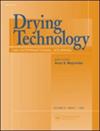Effects of layer inhomogeneities on the process of sewage sludge convective drying
IF 2.7
3区 工程技术
Q3 ENGINEERING, CHEMICAL
引用次数: 0
Abstract
Convective sewage sludge drying is often carried out in belt dryers, where the air flow is directed through the layer. In such a configuration, drying air properties, as well as the structure of the layer and its homogeneity are key factors affecting the drying process. In the present work, these factors were investigated using laboratory experiments on relatively large sludge samples with a mass of several kilograms. Drying was performed at relatively low drying air parameters (time-averaged temperatures of 65 to 80 °C and velocities of 0.44 to 0.78 m/s). The inhomogeneity of the sludge layer drying was observed by measuring the layer surface temperature with an IR camera. The reduction in layer thickness during drying was measured using an optical laser-based method. Analysis of the data included regression and fitting of the data to parametric drying curves, with the modified Nadhari drying law providing the best fit. The standard deviation of the layer surface thermograms (S) was used as a parameter that accounted for the layer homogeneity and consequently drying evenness. Higher values of S corresponded to lower drying rates and consequently longer drying times, highlighting the importance of producing layers with a homogenous structure. The measured layer thickness reduction rate indicated the overall drying intensity almost from the beginning of drying. Both the surface temperature unevenness and the layer height reduction measurement methods were demonstrated as viable approaches for real-time monitoring of the drying process with potential for application in real-scale dryers.层间不均匀性对污泥对流干燥过程的影响
污水污泥的对流干燥通常在带式干燥机中进行,其中气流是直接通过层的。在这种配置下,干燥空气的性质以及层的结构及其均匀性是影响干燥过程的关键因素。在目前的工作中,这些因素是通过实验室实验对质量为几公斤的相对较大的污泥样品进行研究的。干燥在相对较低的干燥空气参数下进行(时间平均温度为65至80°C,速度为0.44至0.78 m/s)。利用红外相机测量污泥层表面温度,观察污泥层干燥的不均匀性。干燥过程中层厚的减少是用光学激光方法测量的。对数据进行回归和参数干燥曲线拟合,修正的Nadhari干燥规律拟合效果最佳。层表面热图的标准偏差(S)被用作表征层均匀性和干燥均匀性的参数。较高的S值对应于较低的干燥速率,因此较长的干燥时间,突出了生产具有均匀结构的层的重要性。测得的层厚减少率几乎反映了干燥开始时的总体干燥强度。表面温度不均匀度和层高降低测量方法都是实时监测干燥过程的可行方法,具有在实际干燥机中应用的潜力。
本文章由计算机程序翻译,如有差异,请以英文原文为准。
求助全文
约1分钟内获得全文
求助全文
来源期刊

Drying Technology
工程技术-工程:化工
CiteScore
7.40
自引率
15.20%
发文量
133
审稿时长
2 months
期刊介绍:
Drying Technology explores the science and technology, and the engineering aspects of drying, dewatering, and related topics.
Articles in this multi-disciplinary journal cover the following themes:
-Fundamental and applied aspects of dryers in diverse industrial sectors-
Mathematical modeling of drying and dryers-
Computer modeling of transport processes in multi-phase systems-
Material science aspects of drying-
Transport phenomena in porous media-
Design, scale-up, control and off-design analysis of dryers-
Energy, environmental, safety and techno-economic aspects-
Quality parameters in drying operations-
Pre- and post-drying operations-
Novel drying technologies.
This peer-reviewed journal provides an archival reference for scientists, engineers, and technologists in all industrial sectors and academia concerned with any aspect of thermal or nonthermal dehydration and allied operations.
 求助内容:
求助内容: 应助结果提醒方式:
应助结果提醒方式:


